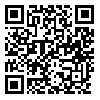Volume 33, Issue 2 (8-2020)
jdm 2020, 33(2): 108-115 |
Back to browse issues page
Download citation:
BibTeX | RIS | EndNote | Medlars | ProCite | Reference Manager | RefWorks
Send citation to:



BibTeX | RIS | EndNote | Medlars | ProCite | Reference Manager | RefWorks
Send citation to:
Yousefi R, Mohammadpanah Ardakan A, Binesh N, Saberi A, Tabatabayi P. The role of personality traits in predicting dental anxiety. jdm 2020; 33 (2) :108-115
URL: http://jdm.tums.ac.ir/article-1-6009-en.html
URL: http://jdm.tums.ac.ir/article-1-6009-en.html
Rahim Yousefi1 
 , Azra Mohammadpanah Ardakan *
, Azra Mohammadpanah Ardakan * 
 2, Nafiseh Binesh3
2, Nafiseh Binesh3 
 , Atefeh Saberi3
, Atefeh Saberi3 
 , Pegah Tabatabayi4
, Pegah Tabatabayi4 


 , Azra Mohammadpanah Ardakan *
, Azra Mohammadpanah Ardakan * 
 2, Nafiseh Binesh3
2, Nafiseh Binesh3 
 , Atefeh Saberi3
, Atefeh Saberi3 
 , Pegah Tabatabayi4
, Pegah Tabatabayi4 

1- Associate Professor, Department of Psychology, Faculty of Psychology and Educational Sciences, Shahid Madani University, Azarbayjan, Iran
2- Assistant Professor, Department of Psychology, Faculty of Humanetic and Social Sciences, Ardakan University, Ardakan, Iran
3- Master Student of Cognitive Sciences, Department of Psychology, Faculty of Educational Sciences and Psychology, Azarbaijan Shahid Madani University, Tabriz, Iran
4- Master Student of Exceptional Child Psychology, Faculty of Educational Sciences and Psychology, Azarbaijan Shahid Madani University, Tabriz, Iran
2- Assistant Professor, Department of Psychology, Faculty of Humanetic and Social Sciences, Ardakan University, Ardakan, Iran
3- Master Student of Cognitive Sciences, Department of Psychology, Faculty of Educational Sciences and Psychology, Azarbaijan Shahid Madani University, Tabriz, Iran
4- Master Student of Exceptional Child Psychology, Faculty of Educational Sciences and Psychology, Azarbaijan Shahid Madani University, Tabriz, Iran
Abstract: (1837 Views)
Background and Aims: Anxiety is a common problem in patients referred to dental clinics that is associated with underlying personality factors. The purpose of this study was to determine the role of personality traits in predicting dental anxiety.
Materials and Methods: In this study, 211 patients (110 men and 101 women) referred to the dental clinics in Tabriz in 2019, were selected by available sampling method. The method of this study is descriptive- correlative. The research instrument was a short-form NEO-personality inventory and a dental anxiety inventory. Data were analyzed by correlation and regression analysis using SPSS22.
Results: The research findings showed that the average age of women and men was 30 and 31 years, respectively. 49% of the clients were single and 51% were married, and the education of most of the clients was undergraduate. Also, Regression analysis showed that dental anxiety had a positive correlation with personality trait of neuroticism (r=-0.49, P<0.01), and it had a negative relationship with extroversion (r=-0.19, P<0.05), agreeableness (r=-0.21, P<0.01), consciences (r=-0.35, P<0.01); and two factors of neuroticism (t=4.71, P<0.01) and conscience (t=2.44, P<0.01), and predicted dental anxiety (P<0.05).
Conclusion: From the results, it can be concluded that anxiety with a sense of danger that was observed in many people in the face of dental interventions, occurred within individuals. By recognizing root factors, it can be partly strengthened by deterrent and suppressor personality factors for anxiety, and thus, taking advantages of the dental services and preventing from avoiding dental treatments.
Materials and Methods: In this study, 211 patients (110 men and 101 women) referred to the dental clinics in Tabriz in 2019, were selected by available sampling method. The method of this study is descriptive- correlative. The research instrument was a short-form NEO-personality inventory and a dental anxiety inventory. Data were analyzed by correlation and regression analysis using SPSS22.
Results: The research findings showed that the average age of women and men was 30 and 31 years, respectively. 49% of the clients were single and 51% were married, and the education of most of the clients was undergraduate. Also, Regression analysis showed that dental anxiety had a positive correlation with personality trait of neuroticism (r=-0.49, P<0.01), and it had a negative relationship with extroversion (r=-0.19, P<0.05), agreeableness (r=-0.21, P<0.01), consciences (r=-0.35, P<0.01); and two factors of neuroticism (t=4.71, P<0.01) and conscience (t=2.44, P<0.01), and predicted dental anxiety (P<0.05).
Conclusion: From the results, it can be concluded that anxiety with a sense of danger that was observed in many people in the face of dental interventions, occurred within individuals. By recognizing root factors, it can be partly strengthened by deterrent and suppressor personality factors for anxiety, and thus, taking advantages of the dental services and preventing from avoiding dental treatments.
Type of Study: Research |
Subject:
operative dentistry
Received: 2020/11/2 | Accepted: 2020/10/31 | Published: 2020/10/31
Received: 2020/11/2 | Accepted: 2020/10/31 | Published: 2020/10/31
Send email to the article author
| Rights and Permissions | |
 |
This work is licensed under a Creative Commons Attribution-NonCommercial 4.0 International License. |


